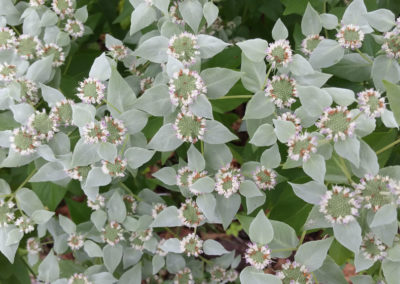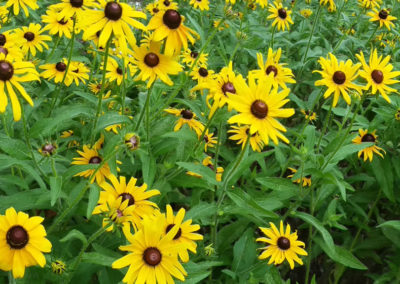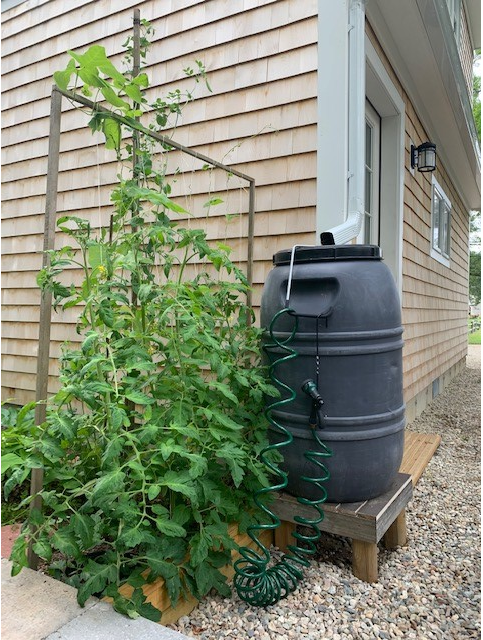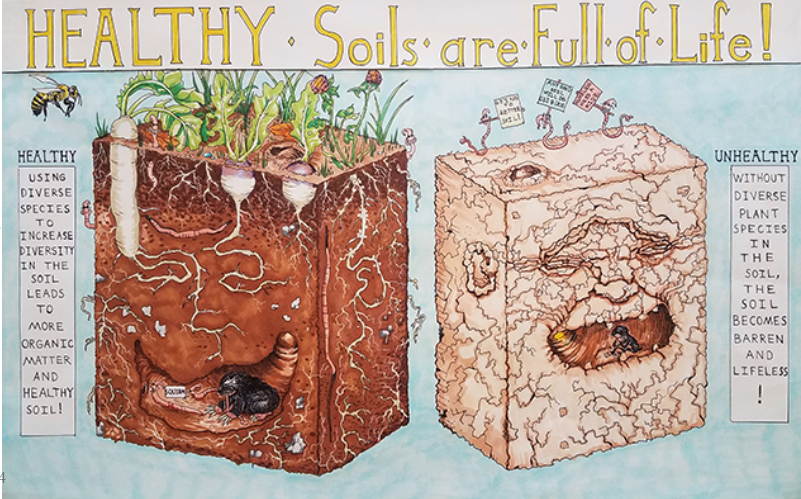Being Carbon Conscious in the Landscape
- Home
- /
- Being Carbon Conscious in...
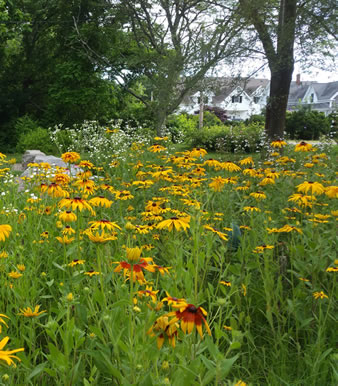 As we work to reduce our carbon footprint in our daily life, we can also be carbon conscious in the choices we make in how we design and maintain our landscapes and gardens. These choices help reduce carbon emissions and store carbon, protect water quality and support local food webs, and help our yards and our communities be more resilient to the impacts of climate change.
As we work to reduce our carbon footprint in our daily life, we can also be carbon conscious in the choices we make in how we design and maintain our landscapes and gardens. These choices help reduce carbon emissions and store carbon, protect water quality and support local food webs, and help our yards and our communities be more resilient to the impacts of climate change.
Our traditional landscapes are an energy suck. The conventional landscape is dominated by non-native species like privet hedge and hydrangeas, heavily mulched with annual replenishing of shredded bark, maybe a few small ornamental trees like Kousa dogwood or Bradford pear, and of course, lots of lush green lawn. If you have this style of landscape, you know it requires irrigation for it to look good during the Cape’s typically dry summers; the hedges need annual pruning; and turf lawn demands chemical input and weekly mowing. Fertilizers, pesticides and herbicides, irrigation and the maintenance to manicure a landscape all represent a significant amount of carbon emissions that can be avoided.
What you can do. Don’t feel overwhelmed if there are some things here you can’t put into practice, just remember, every little bit helps.
Reduce lawn area and plant more plants, shrubs and trees. Less lawn and more plants mean greater biodiversity, which will make your landscape more receptive to rainwater absorption and retention, make it more interesting for you and, with the right plants, can help support local food webs.
For lawn you need, make it a Cape Cod lawn because after all, you live on Cape Cod. A Cape Cod lawn receives no chemical applications or fertilizers and is the best type of lawn to have on Cape Cod because we have a nutrient problem in our ponds and coastal areas and fertilizers are part of the problem. A Cape Cod lawn is whatever grows, and it welcomes a variety of plants, such as violets, white clover and other broad-leaved plants. Even moss is acceptable! A Cape Cod lawn doesn’t need irrigation or amendments. It goes dormant in the dry months and you don’t have to mow. Many a Cape Codder has bragged about how few times they have mowed in a season.
Simply mow less and less often. Reduce the areas you mow, leave some wild edges and reduce the frequency of mowing. If you mow every two weeks instead of every week, you’ve reduced carbon emissions by half. Studies show less frequent mowing and leaving wild patches or edges will also help pollinators.
Eliminate your use of fertilizers and pesticides. Fertilizers and other chemical inputs all come at the cost of carbon emissions. Besides, they are part of our nutrient pollution problem that affects the water quality in our ponds and embayments.
Plant lawn alternatives. Lawn areas have their place for recreation, your pets and general foot traffic, but for portions of your yard you don’t use and still want something low and green, go with native plants that are good at covering the ground. Click here for a list of alternatives.
Plant native species. Many of our native perennials, shrubs and trees are especially drought tolerant and salt spray tolerant. Once established, there is little need to water. They can thrive in the Cape’s nutrient poor, well-drained, acidic soils and therefore do not need fertilizing or soil amendments. Check out CapeCodNativePlants.org – our plant-finder that will help you make the best choice.
Plant more trees and protect existing trees. Trees shade our homes and reduce cooling energy costs. Trees pull carbon out of the air and store it. Trees intercept rainfall to help recharge the aquifer.
Ditch the gas-powered lawnmower. Reduce your carbon emissions and go electric or battery-operated. They are easy to use and quiet. And what about a manual push-mower?
Leave the leaves and ditch the leaf-blower. Leaves recycle nutrients, they are nature’s mulch and help with moisture retention. Leaves provide cover for overwintering bumble bees and other beneficial insects. Leaf-blowers destroy habitat and when used to “sweep” dirt and debris, create air pollution by suspending contaminants in the air. Besides, gas-powered leaf-blowers are carbon emitters (and noisy).
Conserve water, harvest water. Plant natives that are drought tolerant. When temporary irrigation is needed, use drip hoses. Rain barrels can help capture water from a gutter downspout for use in your garden. Or go big and install a cistern for maximum rain-harvesting capacity.
Grow your soil and compost. The point of composting is to recycle nutrients on your site. You can compost your kitchen scraps, like vegetable peelings and coffee grounds (no meat or dairy products). There are all sorts of composting systems. You can start small. Here’s a simple DIY project for your kitchen waste with a 10 gallon pail. Soil organisms find their way into the pail and do all the work. Within a year’s time, turn garbage into compost to add to your vegetable garden. For composting basics, click here. You can either be a lazy composter and just let it pile up or you can work it and see the magic unfold.
Don’t rototill. Sheet mulch instead. Every time we disturb the soil or leave areas exposed to the atmosphere, carbon dioxide is released into the air.
Leave wild areas. Setting aside any areas as wild areas will reduce your maintenance energy input. And by leaving some rough areas, beneficial insects have a place to hide, find food, overwinter, and can also be a place where birds can find food.


